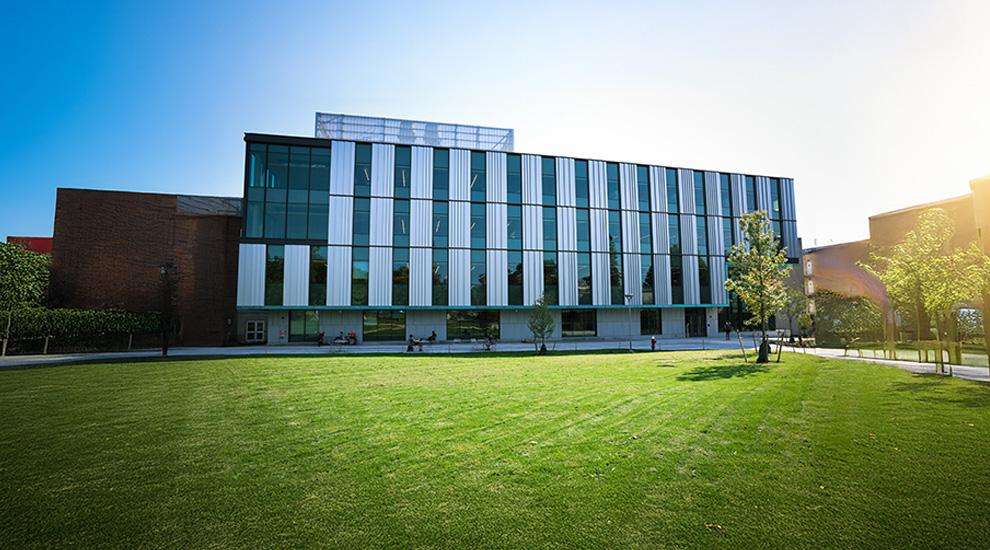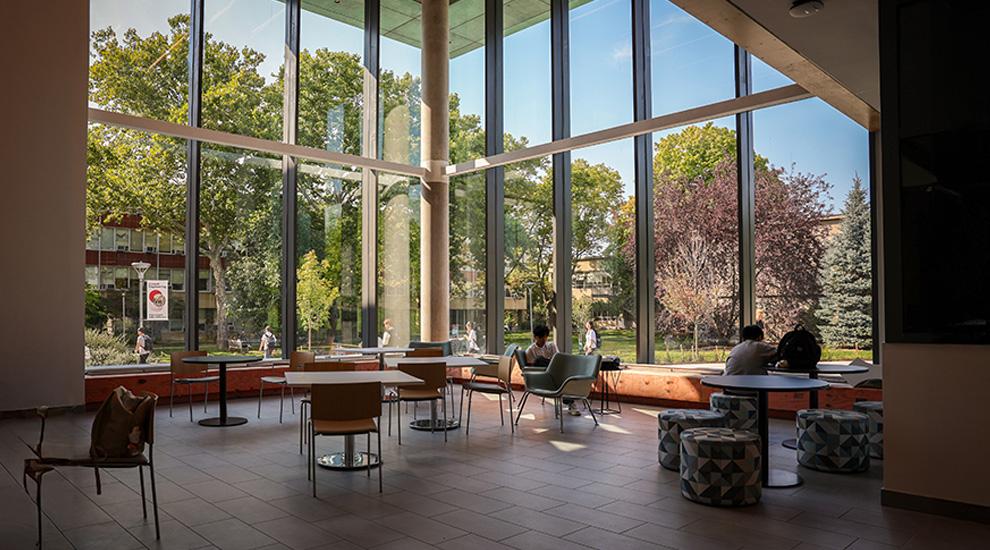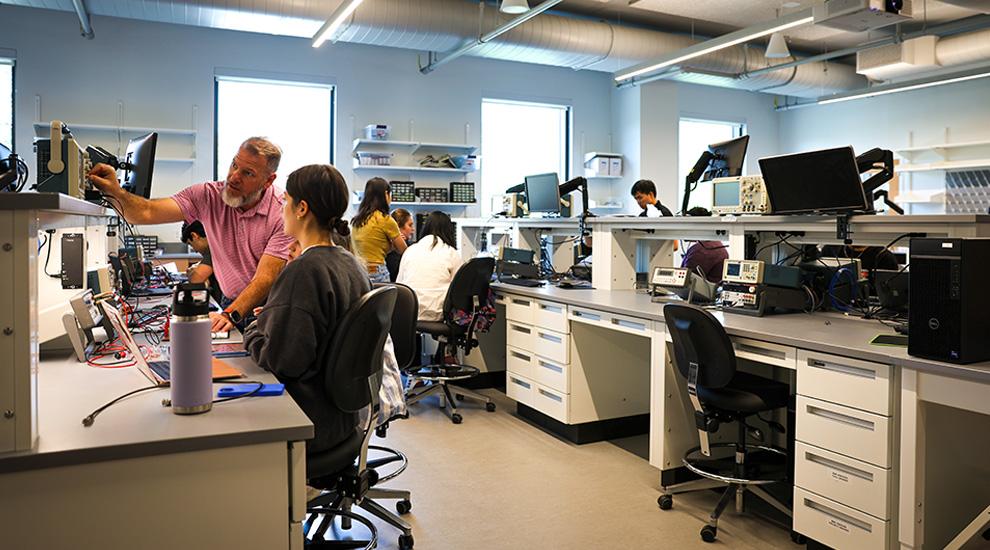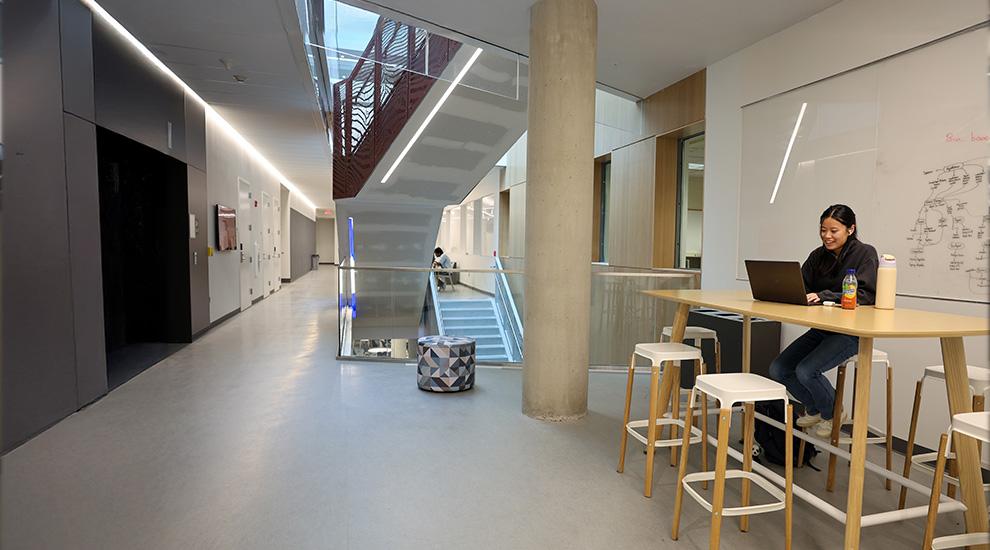BME 20
by Olivia Hall
BME 20: Meinig School celebrates two decades of biomedical engineering at Cornell
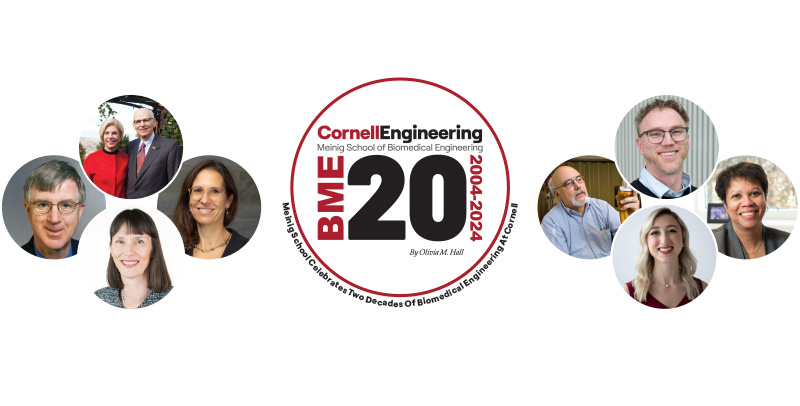
Mike Shuler knew the time was ripe. The year was 1993 and the professor of chemical engineering had noticed the signs around Cornell and the engineering community. “There was a sense of opportunity that came from combining biology and engineering, with important applications in the medical area,” he recounted three decades later as an emeritus professor. Cornell Engineering’s leadership at the time agreed. Shuler was tasked with helming the effort to give shape to this vision.
The result is the Nancy E. and Peter C. Meinig School of Biomedical Engineering, named in 2015 thanks to a $50 million gift from the Meinig family. This year, the school celebrates the 20th anniversary of its founding as a full-fledged department.
Since the inception of biomedical engineering at Cornell – “Cornell BME” as it’s known to the campus community – its researchers have been consistently working on the cutting edge of the field, applying an engineering perspective to the human body as an integrated, multiscale system. In collaborative projects with world-class clinicians, they are using these insights to design better therapies, devices and diagnostic procedures and improve human health. Thanks to the faculty’s commitment to high-quality, hands-on education from the undergraduate to doctoral levels, the school is not only nationally ranked but also one of Cornell Engineering’s fastest-growing academic programs.
“It’s satisfying to see how far we’ve come in a comparatively short amount of time, and we’re proud of the impact we have created with our research and educational programs,” said Claudia Fischbach-Teschl, the Stanley Bryer 1946 Professor of Biomedical Engineering, who assumed leadership of the Meinig School as the James M. and Marsha McCormick Director of Biomedical Engineering earlier this year.
Culturing a new department
While Cornell BME may be young relative to many of its peers at Cornell, the school’s roots at the university can be traced back for decades. Several engineering alumni were influential in the nascent field, such as Wilson Greatbatch ’50, inventor of the first implantable pacemaker, and Robert Langer ’70, whose pioneering work includes controlled drug delivery systems. Faculty whose research might now be considered biomedical engineering were based in various disciplines. By the 1990s, multiple departments across Cornell Engineering and the university had introduced related courses, but the efforts were not yet cohesive.
This changed in 1993, when a committee headed by Shuler began to explore how Cornell should approach teaching bioengineering – the umbrella under which biomedical engineering first developed. Shuler had long been an advocate for integrating life sciences into engineering, and his own research would lead to the body-on-a-chip, a microfluidic device used to observe the complex responses a body may have to medications.
In 1994, the college, under then-associate dean of engineering John Hopcroft, established a bioengineering concentration – consisting of a one-credit seminar and four required courses – and an M.Eng. Dean’s Certificate. This certificate applied to all areas of bioengineering, including BME. Over the next decade, the BME program slowly expanded, gaining state approval as a graduate field specifically in BME with master’s and doctoral degrees (1998) and adding a formal minor in BME for undergraduates (1999).
In 2004, the Department of Biomedical Engineering was officially founded, with faculty consisting of Shuler, Don Bartel, David Putnam, Lawrence Bonassar and William Olbricht. A dozen more in other departments were involved in the graduate field.
“When we became a full-fledged department, we were competing with about 100 other universities that were building their biomedical engineering programs,” said Shuler, who served as founding chair until 2014. “We had to think about building a team of faculty who would complement each other and do intellectually interesting things. And that’s what we did.”
Growth
Shuler went on a hiring spree. He brought in six assistant professors in two years to assemble what he called a “critical mass” of faculty. “It created this environment where, the much more senior Mike Shuler was presiding over a pile of very junior professors,” said professor Jonathan Butcher, who joined the program in 2007. Fischbach-Teschl, hired the same year, called the group “ambitious and fun.”
The cohort grew exceptionally close over the next decade as its members came of age as researchers and educators. “We mentored each other and got comfortable sharing failures and celebrating our successes,” Butcher recalled. While initially the program’s members had been dispersed across several buildings, they were brought into closer physical proximity in 2008 when Weill Hall became biomedical engineering’s administrative home.
Butcher credits Marjolein van der Meulen, the Swanson Professor of Biomedical Engineering and Cornell BME’s chair from 2014 until this year, for ushering the department into adulthood. As the original faculty were promoted to full professorships, external senior hires changed the demographic layout of the department. This created more opportunities for engagement and leadership around the university, as well as raising the profile of the department among its peers, van der Meulen said.
Even through decades of change, a few things stayed the same. For one, “we have excellent staff with minimal turnover,” Fischbach-Teschl noted. And the culture of collegiality and positive energy that Shuler had set up persisted.
Building Bridges
Beyond making Cornell BME a pleasant place to work, the school’s collegiality has a tangible impact on the research conducted by its members. Over the years, van der Meulen has occasionally drawn up network diagrams of who has authored studies together. “There are many papers published with multiple department faculty,” she said. “I feel that’s a real strength of how we work.”
Likewise, Shuler pointed to the high levels of interaction between biomedical engineering at other parts of the university. “This has been a trademark for us,” he said. Especially in the program’s early years, having the right combination of expertise helped attract external grants, he explained.
Three institutions are at the core of Cornell BME’s collaborations. From the beginning, the department emphasized building bridges between the Ithaca campus and NewYork-Presbyterian Hospital/Weill Cornell Medicine in New York City. A key component is the NIH-funded clinical summer immersion program. Established in 2005, it requires first-year Ph.D. students to spend eight weeks shadowing a clinical mentor to see first-hand how BME impacts patient diagnosis and care. Closer to home, the College of Veterinary Medicine, “one of the best vet schools in the world, adds a whole different dimension to our work,” Shuler said. Finally, Hospital for Special Surgery in New York City has been a long-standing partner. Considered the country’s top orthopedic hospital, it performs almost 40,000 surgeries annually.
Over time, research ties may become formalized into centers, ensuring their impact into the future. Don Bartel, now the Willis H. Carrier Professor Emeritus, for example, long cooperated with Albert Burstein, then director of the Department of Biomechanics at Hospital for Special Surgery. Their collaboration not only changed knee replacement surgery and enabled medical breakthroughs in nanobiotechnology, but eventually created the Center for Advanced Materials and Engineering in Orthopaedics with a roster of around 50 biologists, material scientists, mechanical engineers, veterinarians and surgeons.
These collaborations provide biomedical engineering faculty and students with access to vast amounts of clinical data, samples, and the expertise of clinicians. Most importantly, van der Meulen noted, many research opportunities arise from understanding the challenges being seen in the clinics – often during doctoral students’ immersions. She pointed to Fischbach-Teschl’s work, for example, in which observations that metastases occur mainly in bone led to research asking why the skeleton =is a hospitable environment for circulating tumor cells. “The most rewarding outcome is when results can then be translated to the clinical side,” van der Meulen said. “We’re not doing this as an intellectual exercise, we’re doing it to improve human health.”
Making an impact
The Meinig School’s faculty have produced impactful research in a variety of areas, van der Meulen said, highlighting three. For one, Cornell BME is known for tissue engineering across multiple types of organs, including in the cardiovascular, cancer, orthopedic, and soft tissue arenas. Lawrence Bonassar, the Daljit S. and Elaine Sarkaria Professor in Biomedical Engineering, for example, credits Cornell’s interdisciplinary environment with helping to foster a pioneering collaboration in 3D bioprinting. In a first-of-its-kind clinical trial, a human received a 3D-bioprinted ear – grown from the patient’s own living cells – thanks to a technology platform developed by a startup company co-founded by Bonassar.
Specializations in imaging stem from Cornell’s historic strengths in applied and engineering physics, focused on living systems in BME. For example, a team led by associate professor Nozomi Nishimura used three-photon microscopy to produce high-resolution images of individual fat cells on arterial walls in mouse and human tissue samples. These deposits are the earliest evidence of plaque buildup, which can cause heart disease and stroke. Multi-photon microscopy is thereby proving to be a powerful research tool with promise for clinical applications in the future.
Finally, van der Meulen sees particular strengths in materials and biomaterials. In this area, Yadong Wang, the McAdam Family Foundation Professor of Cardiac Assist Technology, worked with Ying Chen, then a postdoctoral associate, to design a modular process for engineering biocompatible and biodegradable elastomers – polymers with rubber-like properties. They discovered that using chelating ligands – molecules that tightly bind a metal ion using two or more bonds – allows mixing different metals with a single polymer. Potential applications include grafts that can repair blood vessels and heart tissue.
Thanks to such cutting-edge science, Cornell BME faculty have been highly successful in winning large grants from the National Institutes of Health and the National Science Foundation. They also have among their ranks 15 fellows of the American Institute of Medical and Biological Engineers as well as five members of the National Academy of Inventors – more than any other school at Cornell and a testament to their ability to turn research into devices that help people.
Raising the next generation of researchers
Not surprisingly, such a distinguished faculty has proven highly attractive to students looking to be trained as biomedical engineers. Nearly two decades after Cornell BME’s graduate field was established, the department was empowered by college leadership to create a brand new, “no-holds-barred” vision for an undergraduate program. “We had the advantage of seeing what existing biomedical engineering programs had already done, while being able to poll companies to see what skills and tools we need to provide students with to meet industry needs,” said Butcher, who subsequently served as founding director of undergraduate studies.
The resulting major graduated its first class in 2018. “Adding the major made biomedical engineering kind of a full, grown-up department,” van der Meulen said. The program takes students through a core sequence of courses, plus one of four concentrations and a capstone team design experience. “We hope to provide our students with a solid foundation in the field and prepare them for work and innovation at the interface of many different disciplines,” said Shivaun Archer, the John & Janet Swanson Senior Lecturer and current director of undergraduate studies.
Students appreciate the major’s holistic and hands-on approach. “I really got to be in the lab with my classmates and working on group projects and imaging tumor spheroids,” said Hannah Childs ’18, now a consultant with Boston Consulting Group. The new state-of-the-art design complex spaces in Tang Hall serve student design teams and faculty in exploring their ideas, from conception through implementation and production of prototypes. Thanks to the recent addition of assistant professor Alexandra Werth to the faculty roster, the professional applicability of the engineering labs and design spaces will only continue to increase. Werth is one of only three tenure-track, discipline-based education researchers embedded within biomedical engineering departments in the country. “The university and Cornell BME are really leaders in this space at the moment,” Werth said.
Students’ enthusiasm for biomedical engineering has grown steadily since 19 sophomores affiliated with the new major in the spring of 2016. The most recent senior cohort has 70 members. And external recognition followed quickly. Cornell BME has been consistently rising in the U.S. News & World Report rankings, coming in at #11 in 2023 – the same year it completed its accreditation through the Accreditation Board for Engineering and Technology (ABET). Cornell BME is also the only major in the college to receive a commendation from ABET for its high level of diversity. With 79 percent average female enrollment in the 2018 to 2022 classes, the Meinig School helped Cornell Engineering achieve undergraduate gender parity.
“I think what makes our students unique is how passionate they are, they really want to apply what they learn and make a difference,” Archer said. Many can be found doing community outreach work, introducing potential future scientists to the field at the annual Girl Scout Engineering Day or science, technology, engineering, arts and math (STEAM) nights at a local elementary school. Having obtained their degrees, graduates enjoy high levels of success securing jobs to apply their skills with big pharmaceutical companies, manufacturers of biomedical devices, government laboratories, and smaller companies.
A vision for the next 20 years
Looking toward the future, Fischbach-Teschl hopes to keep building on the successes Cornell BME’s faculty and graduates have amassed over two short decades. “My goal as director is to continue strengthening our national and global reputation,” she said.
Fischbach-Teschl is especially excited about the college’s Innovations in Medicine initiative, which aims to foster collaborations with Weill Cornell Medicine that transcend traditional disciplines. “The initiative will help translate faculty research discoveries into clinical practice,” she said.
Thanks to a recent four-story addition to Thurston Hall, which has been renamed Tang Hall, Cornell BME and other engineering departments now have a lot more space for this work. About 30,000 square feet of new laboratory, teaching and meeting spaces will provide the Meinig School with new opportunities for collaborations and a visible presence at the heart of the Engineering Quad.
“I believe we are in an excellent position – on campus and figuratively – to play a huge role in driving impactful technologies and discoveries,” Fischbach-Teschl said, “and in educating the next generation of scientists and engineers who will meaningfully contribute to society and sustained well-being in the world.”


